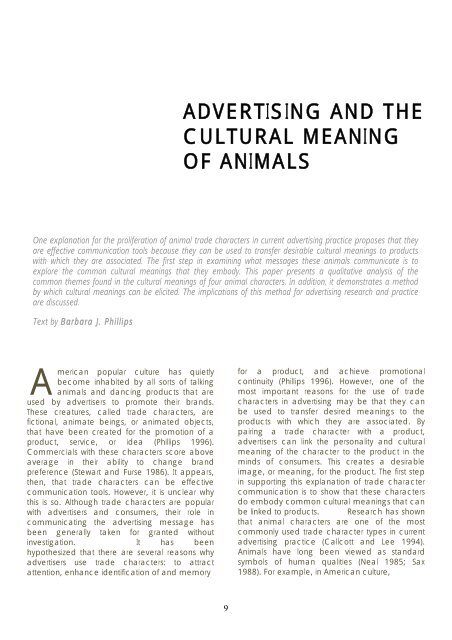Marketing Animals - Antennae The Journal of Nature in Visual Culture
Marketing Animals - Antennae The Journal of Nature in Visual Culture
Marketing Animals - Antennae The Journal of Nature in Visual Culture
Create successful ePaper yourself
Turn your PDF publications into a flip-book with our unique Google optimized e-Paper software.
A<br />
merican popular culture has quietly<br />
become <strong>in</strong>habited by all sorts <strong>of</strong> talk<strong>in</strong>g<br />
animals and danc<strong>in</strong>g products that are<br />
used by advertisers to promote their brands.<br />
<strong>The</strong>se creatures, called trade characters, are<br />
fictional, animate be<strong>in</strong>gs, or animated objects,<br />
that have been created for the promotion <strong>of</strong> a<br />
product, service, or idea (Phillips 1996).<br />
Commercials with these characters score above<br />
average <strong>in</strong> their ability to change brand<br />
preference (Stewart and Furse 1986). It appears,<br />
then, that trade characters can be effective<br />
communication tools. However, it is unclear why<br />
this is so. Although trade characters are popular<br />
with advertisers and consumers, their role <strong>in</strong><br />
communicat<strong>in</strong>g the advertis<strong>in</strong>g message has<br />
been generally taken for granted without<br />
<strong>in</strong>vestigation. It has been<br />
hypothesized that there are several reasons why<br />
advertisers use trade characters: to attract<br />
attention, enhance identification <strong>of</strong> and memory<br />
ADVERTISING AND THE<br />
CULTURAL MEANING<br />
OF ANIMALS<br />
One explanation for the proliferation <strong>of</strong> animal trade characters <strong>in</strong> current advertis<strong>in</strong>g practice proposes that they<br />
are effective communication tools because they can be used to transfer desirable cultural mean<strong>in</strong>gs to products<br />
with which they are associated. <strong>The</strong> first step <strong>in</strong> exam<strong>in</strong><strong>in</strong>g what messages these animals communicate is to<br />
explore the common cultural mean<strong>in</strong>gs that they embody. This paper presents a qualitative analysis <strong>of</strong> the<br />
common themes found <strong>in</strong> the cultural mean<strong>in</strong>gs <strong>of</strong> four animal characters. In addition, it demonstrates a method<br />
by which cultural mean<strong>in</strong>gs can be elicited. <strong>The</strong> implications <strong>of</strong> this method for advertis<strong>in</strong>g research and practice<br />
are discussed.<br />
Text by Barbara J. Phillips<br />
9<br />
for a product, and achieve promotional<br />
cont<strong>in</strong>uity (Phillips 1996). However, one <strong>of</strong> the<br />
most important reasons for the use <strong>of</strong> trade<br />
characters <strong>in</strong> advertis<strong>in</strong>g may be that they can<br />
be used to transfer desired mean<strong>in</strong>gs to the<br />
products with which they are associated. By<br />
pair<strong>in</strong>g a trade character with a product,<br />
advertisers can l<strong>in</strong>k the personality and cultural<br />
mean<strong>in</strong>g <strong>of</strong> the character to the product <strong>in</strong> the<br />
m<strong>in</strong>ds <strong>of</strong> consumers. This creates a desirable<br />
image, or mean<strong>in</strong>g, for the product. <strong>The</strong> first step<br />
<strong>in</strong> support<strong>in</strong>g this explanation <strong>of</strong> trade character<br />
communication is to show that these characters<br />
do embody common cultural mean<strong>in</strong>gs that can<br />
be l<strong>in</strong>ked to products. Research has shown<br />
that animal characters are one <strong>of</strong> the most<br />
commonly used trade character types <strong>in</strong> current<br />
advertis<strong>in</strong>g practice (Callcott and Lee 1994).<br />
<strong>Animals</strong> have long been viewed as standard<br />
symbols <strong>of</strong> human qualities (Neal 1985; Sax<br />
1988). For example, <strong>in</strong> American culture,












